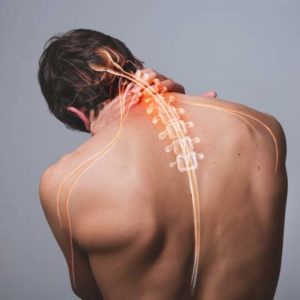Last Modified on October 30, 2023 by Dr. Tyler Meier

In today’s world, exercise and maintenance of a healthy body posture have become central to our overall wellbeing. Not only does regular exercise help us maintain a healthy weight and prevent chronic diseases such as heart disease and diabetes, but it also helps to promote good mental health, an energetic lifestyle, and a sense of fulfillment. However, over-exercise has become a common phenomenon. It’s easy to get caught up in the hype and feel like more is always better. Unfortunately, too much exercise can lead to injury and even damage to your posture. That’s why it’s essential to listen to your body and pay attention to your posture while working out.
Dr. Tyler Meier, a specialist in the musculoskeletal system at CorePosture Chiropractic, has seen this problem all too often. His expertise in Chiropractic BioPhysics® has equipped him to help people maintain healthy posture even during training and exercise. Here are his tips for maintaining healthy posture while working out.
Tip #1: Warm-up and stretch before exercising
Before starting your exercise regimen, always warm-up and stretch. Your body needs to be ready for the workout, and this reduces the risk of injury. Additionally, stretching can help to improve your flexibility, range of motion, and posture.
Dynamic stretching is an excellent way to help your body prepare for exercise, including foam-rolling, lunges, and leg swings. Static stretching, such as hip flexor stretches and neck rolls, can also help to release tension in your muscles before exercising.
Warming up and stretching prior to exercising are key prevention measures for both immediate and long-term injuries, including those that may affect our posture. The act of warming up gradually raises your body’s temperature and increases blood flow to your muscles, which makes them more flexible and efficient, thereby reducing the likelihood of strains and pulls. This period also provides a crucial opportunity for the body to prepare for the increased demands of exercise, ensuring that the muscles and joints are optimized for movement and load-bearing.
Stretching, on the other hand, plays a pivotal role in maintaining and improving the flexibility of our muscles and joints, which is crucial for preserving good posture. It can help counteract the shortening and tightening of muscles that commonly occur with excessive exercise and can lead to postural imbalances. For example, overly tight chest muscles can pull your shoulders forward, leading to a slouched posture. Regular stretching can help to lengthen these muscles, promoting a more balanced and upright posture. Furthermore, flexibility aids in the prevention of injuries by improving the range of motion in our joints, allowing us to move more freely and efficiently during exercise.
Tip #2: Avoid overtraining
Overtraining is a common issue faced by many exercise enthusiasts. Instead of trying to push your body harder, listen to it and rest when needed. Overtraining can lead to muscle tension and fatigue, which significantly affects your posture.
Rest is critical for your body to recover and repair. You need to give your muscles time to recover and rebuild between workouts. Overtraining can also lead to dehydration and headaches, which can further affect your posture.
Overtraining can have a detrimental impact on your posture by causing muscular imbalances and excessive strain, which can eventually lead to injuries. When we over-exercise, we often overuse certain muscle groups while underutilizing others. Such imbalances can alter your body alignment and cause postural issues. For instance, overexerting your chest and abdominal muscles while neglecting your back and glutes can lead to a hunched or rounded posture. This is because these stronger muscles pull the body out of alignment, causing the weaker opposing muscles to lengthen and weaken further.
Injuries resulting from overtraining are often due to the excessive strain put on the joints, tendons, ligaments, and muscles. Consistently overloading these structures without adequate recovery can lead to conditions like tendonitis, stress fractures, and sprains. Furthermore, the altered posture resulting from overtraining and muscular imbalances can exacerbate these injuries. A compromised posture can put excessive pressure on certain parts of the body and can lead to chronic pain and restricted movement. Additionally, overtraining can also result in a weakened immune system, making you more susceptible to illness and injury. Hence, it is crucial to balance exercise with rest and recovery to maintain a good posture and avoid injuries.
Tip #3: Incorporate strength training
Incorporating strength training can significantly help improve overall posture. Strength training exercises such as squats, planks, and deadlifts target specific muscles, including your core, glutes, and back extensors. These exercises strengthen your muscles, improve flexibility, and correct poor posture.
However, it’s crucial to maintain proper form when strength training. When done incorrectly, these exercises can cause severe harm to your posture. You should always work with a trainer or chiropractor who can help guide you in maintaining proper form while exercising.
Strength training, when done correctly, can significantly contribute to preserving spinal alignment. The spine’s structural integrity is maintained by a delicate balance of muscle strength and flexibility. By targeting specific muscle groups that support the spine – such as the erector spinae (back extensors), rectus abdominis (abs), and gluteal muscles (glutes) – strength training can help maintain this balance. It can strengthen the muscles that keep the spine in its natural, neutral position, counteracting the negative effects of sedentary behaviors or postural imbalances that may lead to a misaligned spine.
Moreover, strength training can also enhance the effectiveness and longevity of chiropractic adjustments. When muscles are strong and flexible, they are better able to hold the spine in its adjusted position post chiropractic care. This means that the positive impacts of a chiropractic adjustment may last longer with the support of a robust muscular system. In contrast, weak or imbalanced muscles might allow the spine to revert back to its misaligned state more quickly, negating the benefits of the chiropractic adjustment. Thus, incorporating regular strength training into your routine can serve as a valuable adjunct to chiropractic care, supporting long-term spinal health and postural integrity.
Tip #4: Pay attention to your posture while exercising
It’s easy to let your posture slip while exercising, especially when training with weights. However, paying attention to your posture can help protect your back, neck, and spine from injury. Maintaining proper form while lifting weights or performing other exercises is essential for your overall posture, health, and wellbeing.
For example, when lifting weights, your spine needs to be straight, shoulders rolled back, and abdominal muscles engaged. Your feet should also be in a neutral position so that your weight is evenly distributed and your posture is balanced.
Tip #5: Schedule regular chiropractic adjustments
Scheduling regular chiropractic adjustments can help keep your spine in alignment and reduce the risk of injury while exercising. Regular chiropractic care will help you maintain a healthy posture by alleviating pressure on your muscles and joints.
Chiropractic Care for Injuries and Athletes in Newport Beach, CA
Maintaining a healthy posture is essential for exercising and overall well being. At CorePosture Chiropractic – Chiropractor in Newport Beach, Dr. Tyler Meier can help you maintain that healthy posture while still training and exercising. By following these five tips, you can reduce the risk of injury and achieve better results from your workout routine. Remember always to listen to your body and work with a chiropractor or trainer to maintain good form. You don’t have to choose between great posture and regular exercise and health – you can have both!

Dr. Tyler Meier is a board-certified, licensed chiropractor and founder of CorePosture Chiropractic in Newport Beach, CA







